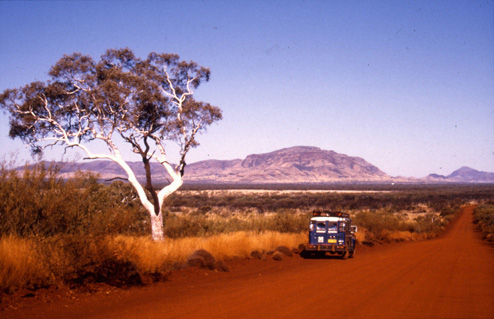Australia For Visitors > Pilbara, WA
Pilbara
Western Australia
Share this page:
The Pilbara is vast (502,000 square kilometers) dry area in the northwest of Western Australia. It has enormous mineral deposits but few inhabitants (the population is just over 50,000).
The landscape of the Pilbara includes coastal plains, mountain ranges, cliffs and gorges, and it includes some of the oldest rock formations on the planet (such as ancient fossilized remains called stromalites and also granites which date back more than three billion years). The area also has revealed some of the oldest evidence of life on Earth (for example, in the sandstones at Strelley Pool, which date back 3.4 billion years and which have preserved fossils of sulfur-processing bacteria).

The Hamersley Ranges in the Pilbara region of Western Australia
(Photo: Anne Dollin)
This area is rich in iron ore, around which a large mining industry has developed and which contribute billions of dollars to the Australian economy.
Petroleum and natural gas, from the NorthWest Shelf Venture, off the coast near Karratha, are two more big export earners.
Other industries include the cattle industry, fishing and (recently) tourism.
Major towns in the Pilbara are Karratha, Newman, and Port Headland.
A Little History
In 1861 the Pilbara was explored by Francis Thomas Gregory.
There was some pastoral (cattle) and agricultural activity in the 19th century, but it was not until 1937 when mining started at Wittenoom Gorge and until the 1960s when iron ore was discovered in the Hamersley Ranges that the Pilbara really took off economically. Mining became the most important source of revenue to the economy of Western Australia. Because of the geographical isolation of mining areas, whole towns had to be built to house the miners and allied workers.
Climate
The Pilbara's climate is arid (dry) and tropical.
In the summer there are tropical cyclones (and the torrential rainfalls are commonly accompanied by flooding); in other seasons, rainfall is rare and temperatures are high.
The Pilbara township of Marble Bar is famous for its extremely hot weather. In the period 31 October 1923 to 7 April 1924, Marble Bar set a record, never yet broken, for the longest period of consecutive days (160 days) with maximum temperatures of 100 degrees Fahrenheit or more.
Mining
The Pilbara's most important industries today are the export of iron ore and petroleum.
The Pilbara's iron ore is mostly mined in the vicinities of Mt Tom Price and Newman. The Pilbara is estimated to have 24 billion tonnes of iron in the ground, of which 324 million tonnes is exported annually.
The iron ore in the Pilbara was discovered in 1952 by the prospector, Lang Hancock (1909-92) and large tracts of Pilbara iron ore are still controlled by Hancock's daughter, Gina Rinehart, and the family company, Hancock Prospecting. Ms Rinehart is currently Australia's richest woman.
The iron ore (and other minerals) are transported from the inland mines to coastal ports (Port Headland, Dampier, Cape Lambert) by four heavy-duty railway lines, all of them operated by the mining companies (Rio Tinto, BHP Billiton, Fortescue Metals Group). The trains operating on these lines are renowned for their length (several kilometers long each).
Apart from iron ore, some of the world's biggest manganese mines and recent mining operations for blue asbestos are located in the Pilbara.
Wool, Tourism
The Pilbara has a number of large sheep farms and a healthy tourism sector.
Tourists come primarily to visit the Karjini National Park, the Millstream-Chichester National Park, the Dampier Archipelago, and the Ningaloo Reef.
Flora and Fauna
The main flora in the Pilbara are the acacia (wattle) trees and shrubs and spinifex grasses.
The Pilbara's fauna includes tens of species of stygofauna (small invertebrates that live in the underground waters and aquifers), the Pilbara Ningaui (a small carnivorous marsupial), the Olive Python, the Western Pebble-Bound Mouse, and many species of birds such as Australian Hobby, Budgerigars, Mulga Parrot, Nankeen kestrel, Spotted Harrier, and Sulphur-Crested Cockatoos.
There are many species of flora and fauna which are endemic (found nowhere else in the world). The iron, natural gas and cattle industries have badly damaged the local culture and environment, but protective steps are now being taken, for example, by declaring the Karijini and Millstream-Chichester National Parks.
Share this page:
Author: David Paul Wagner
(David Paul Wagner on Google+)
|